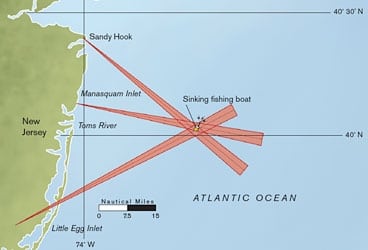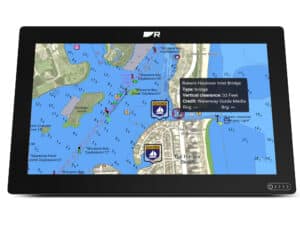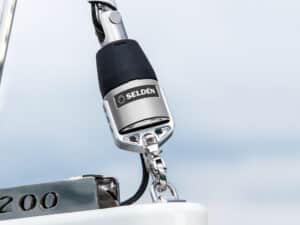
vhf tricks 368
Early in the morning of December 29, 1997, a faint VHF radio signal was heard by a watchstander at the U.S. Coast Guard station in Charleston, South Carolina. “Mayday. U.S. Coast Guard, come in.” The petty officer monitoring the radio answered the call but got no reply. A few minutes later, a second, more garbled broadcast was received, but again, no one responded when the Coast Guardsman replied. Since he couldn’t determine from where the call had come, no search was initiated. Four hours later, shortly after 0600, a crewmember on an inbound freighter heard a cry for help from the water. A nearby pilot boat was sent to look, but the crew spotted no one, either.
That day, the bodies of a man and his 16-year-old son were found in the water near the rock jetties that protect the entrance to Charleston, and two unconscious boys, one the man’s 13-year-old son, the other his 14-year-old nephew, were found on the beach; they later died. It turns out that the man’s 34-foot sailboat, Morning Dew, had hit the jetty sometime in the early hours and sank. (See “The Mayday Call That Shook the Coast Guard,” April 2000.) Following a lawsuit by the man’s family and a Congressional hearing, it was determined that the petty officer was at fault for not launching an investigation and that the Coast Guard’s antiquated communications and distress system desperately needed an overhaul. Indeed, that force was saddled with a 30-year-old system with little or no direction-finding capability, numerous gaps in communications coverage, limited interoperability with other emergency-response services, and single-channel radio operation, which prohibited the reception of multiple radio calls at the same time.
It’s been a while in the making, but a much-needed upgrade is finally ready for prime time. It’s called Rescue 21, a name that’s a lot catchier than the Coast Guard’s original choice, The National Distress and Response System Modernization Program. According to the Coast Guard’s public statements, the new moniker is meant to imply that it’s taking its communications system into the 21st century, and it’s taking the “search” out of search and rescue. But in order to fully take advantage of it, sailors need to upgrade their old VHF radios to ones equipped with digital selective calling.
DSC signals received by the Coast Guard’s new Rescue 21 system greatly enhance your chances of rescue, since the DSC transmissions provide direction-finding capability for tracing a garbled radio signal to within at least 25 miles. Coast Guard receivers can also pick up a signal from a 1-watt VHF radio and provide a line of bearing out to at least 20 nautical miles, even if the caller only keys the microphone for half a second. Rescue 21 also allows the playback of VHF voice or digital calls and automatically tracks Coast Guard ships and aircraft involved with search-and-rescue missions.
New radios, government computer systems, radio towers, and better training will all combine to provide the Coasties with a leading-edge VHF-based system that will replace the creaky National Distress Response System installed and deployed during the 1970s. Rescue 21 is currently being implemented to cover the more than 95,000 miles of coastline, navigable rivers, and waterways in the continental United States, Alaska, Hawai’i, Guam, and Puerto Rico. It isn’t nationwide yet, may not be fully complete for the continental United States until 2009, and isn’t expected to be fully operational in Puerto Rico, Guam, and Alaska until 2011. But as of last spring, 13,500 miles of coastline were covered by the service, including Sector New York down to Sector Hampton Roads, Virginia, both coasts of Florida, a large chunk of the eastern part of the Gulf Coast, and parts of the Pacific Northwest.
Rescue 21 has already proven its worth during the toughest time of year in Northeast waters. In February 2008, 12 miles off Fire Island, New York, the 38-foot fishing vessel Green Eyes sank in 10- to 12-foot seas with winds gusting to 45 knots. The vessel’s EPIRB didn’t work, but its VHF’s Mayday signal was plotted by two Rescue 21 centers, and a Coast Guard helicopter crew, despite the 42 F water temperature, rescued the three-man crew.
In March, the crew of a 90-foot fishing vessel were in distress 30 miles off New Jersey and were unable to provide their position to rescuers. This time, multiple Rescue 21 centers were used to plot the signal, and all four crewmembers were rescued.
The Coasties aren’t the only folks listening for DSC-broadcast emergencies at sea; all commercial vessels greater than 300 tons are also required to monitor reserved DSC radio Channel 70 for distress calls. This means that in the event that you have to hit the red emergency button on your DSC radio, your chances of rescue these days should be greatly enhanced over the old days, when you’d broadcast Mayday on VHF 16 and hope that somebody would find you.
Tony Bessinger is Cruising World’s electronics editor.








